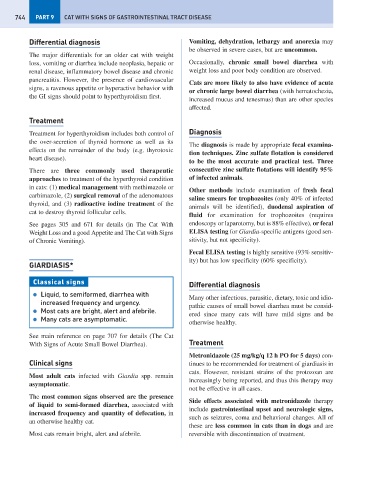Page 752 - Problem-Based Feline Medicine
P. 752
744 PART 9 CAT WITH SIGNS OF GASTROINTESTINAL TRACT DISEASE
Differential diagnosis Vomiting, dehydration, lethargy and anorexia may
be observed in severe cases, but are uncommon.
The major differentials for an older cat with weight
loss, vomiting or diarrhea include neoplasia, hepatic or Occasionally, chronic small bowel diarrhea with
renal disease, inflammatory bowel disease and chronic weight loss and poor body condition are observed.
pancreatitis. However, the presence of cardiovascular
Cats are more likely to also have evidence of acute
signs, a ravenous appetite or hyperactive behavior with
or chronic large bowel diarrhea (with hematochezia,
the GI signs should point to hyperthyroidism first.
increased mucus and tenesmus) than are other species
affected.
Treatment
Treatment for hyperthyroidism includes both control of Diagnosis
the over-secretion of thyroid hormone as well as its
The diagnosis is made by appropriate fecal examina-
effects on the remainder of the body (e.g. thyrotoxic
tion techniques. Zinc sulfate flotation is considered
heart disease).
to be the most accurate and practical test. Three
There are three commonly used therapeutic consecutive zinc sulfate flotations will identify 95%
approaches to treatment of the hyperthyroid condition of infected animals.
in cats: (1) medical management with methimazole or
Other methods include examination of fresh fecal
carbimazole, (2) surgical removal of the adenomatous
saline smears for trophozoites (only 40% of infected
thyroid, and (3) radioactive iodine treatment of the
animals will be identified), duodenal aspiration of
cat to destroy thyroid follicular cells.
fluid for examination for trophozoites (requires
See pages 305 and 671 for details (in The Cat With endoscopy or laparotomy, but is 88% effective), or fecal
Weight Loss and a good Appetite and The Cat with Signs ELISA testing for Giardia-specific antigens (good sen-
of Chronic Vomiting). sitivity, but not specificity).
Fecal ELISA testing is highly sensitive (93% sensitiv-
ity) but has low specificity (60% specificity).
GIARDIASIS*
Classical signs Differential diagnosis
● Liquid, to semiformed, diarrhea with
Many other infectious, parasitic, dietary, toxic and idio-
increased frequency and urgency.
pathic causes of small bowel diarrhea must be consid-
● Most cats are bright, alert and afebrile.
ered since many cats will have mild signs and be
● Many cats are asymptomatic.
otherwise healthy.
See main reference on page 707 for details (The Cat
With Signs of Acute Small Bowel Diarrhea). Treatment
Metronidazole (25 mg/kg/q 12 h PO for 5 days) con-
Clinical signs tinues to be recommended for treatment of giardiasis in
cats. However, resistant strains of the protozoan are
Most adult cats infected with Giardia spp. remain
increasingly being reported, and thus this therapy may
asymptomatic.
not be effective in all cases.
The most common signs observed are the presence
Side effects associated with metronidazole therapy
of liquid to semi-formed diarrhea, associated with
include gastrointestinal upset and neurologic signs,
increased frequency and quantity of defecation, in
such as seizures, coma and behavioral changes. All of
an otherwise healthy cat.
these are less common in cats than in dogs and are
Most cats remain bright, alert and afebrile. reversible with discontinuation of treatment.

